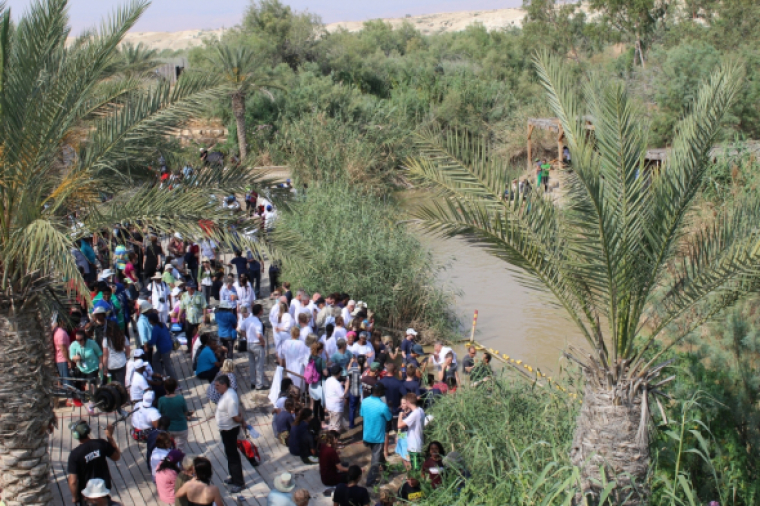Site near Jordan River could hold evidence for biblical account of Exodus

Historical evidence for the biblical account of the Exodus might be located at a site near the Jordan River, according to a recently announced discovery.
Exodus, the second book of the Bible, has been a subject of much debate over its historical accuracy, as some scholars have questioned the claim that the ancient Israelites immigrated from Egypt during that time period.
However, at the Jordan Valley site of Khirbet el-Mastarah, archaeologists Ralph K. Hawkins and David Ben-Shlomo have said that there is evidence of ruins from a nomadic people believed to be the Hebrews coming from Egypt.
Ben-Shlomo said in comments quoted by the U.K. Daily Express on Tuesday that the ruins offer potential evidence for the biblical account.
"We have not proved that these camps are from the period of the early Israelites, but it is possible," noted Ben-Shlomo.
"If they are, this might fit the biblical story of the Israelites coming from east of the Jordan River, then crossing the Jordan and entering into the hill country of Israel later."
Ben-Shlomo and Hawkins had their findings published in the July/August 2018 edition of Biblical Archaeology Review, noting that the ruins appear to date to the Iron Age, which would be around the time of the Exodus.
In comments given to the Biblical Archaeology Society during the summer, Ben-Shlomo and Hawkins said their findings came from research on the site conducted in the summer of 2017.
At Khirbet el-Mastarah, they found among other things stone ruins and pottery fragments dating to either the Late Bronze Age (1400–1200 B.C.) or the Iron Age (1200–1000).
"By the end of our 2017 season, we were struck by the fascinating picture that had begun to emerge in the Jordan Valley, a region that up until recently has been virtually unknown archaeologically," said Ben-Shlomo and Hawkins.
"Within a range of just a couple of miles, we may be able to see the evolution of early Israel from a domestic-scale culture [at Khirbet el-Mastarah] to a political-scale culture [at Khirbet 'Auja el-Foqa]."
The aforementioned Khirbet 'Auja el-Foqa has been identified by researchers with the ancient city of Ataroth, as referenced in Joshua 16:5.
This article was originally published in The Christian Post and is re-published here with permission
 Christians don't have to affirm transgenderism, but they can’t express that view at work: tribunal
Christians don't have to affirm transgenderism, but they can’t express that view at work: tribunal Archaeology discovery: Medieval Christian prayer beads found on Holy Island
Archaeology discovery: Medieval Christian prayer beads found on Holy Island Presbyterian Church in America votes to leave National Association of Evangelicals
Presbyterian Church in America votes to leave National Association of Evangelicals Over 50 killed in 'vile and satanic' attack at Nigerian church on Pentecost Sunday
Over 50 killed in 'vile and satanic' attack at Nigerian church on Pentecost Sunday Ukrainian Orthodox Church severs ties with Moscow over Patriarch Kirill's support for Putin's war
Ukrainian Orthodox Church severs ties with Moscow over Patriarch Kirill's support for Putin's war Islamic State kills 20 Nigerian Christians as revenge for US airstrike
Islamic State kills 20 Nigerian Christians as revenge for US airstrike Man who served 33 years in prison for murder leads inmates to Christ
Man who served 33 years in prison for murder leads inmates to Christ


 Nigerian student beaten to death, body burned over ‘blasphemous’ WhatsApp message
Nigerian student beaten to death, body burned over ‘blasphemous’ WhatsApp message 'A new low': World reacts after Hong Kong arrests 90-year-old Cardinal Joseph Zen
'A new low': World reacts after Hong Kong arrests 90-year-old Cardinal Joseph Zen Iran sentences Christian man to 10 years in prison for hosting house church worship gathering
Iran sentences Christian man to 10 years in prison for hosting house church worship gathering French Guyana: Pastor shot dead, church set on fire after meeting delegation of Evangelicals
French Guyana: Pastor shot dead, church set on fire after meeting delegation of Evangelicals ‘Talking Jesus’ report finds only 6% of UK adults identify as practicing Christians
‘Talking Jesus’ report finds only 6% of UK adults identify as practicing Christians Mission Eurasia ministry center blown up in Ukraine, hundreds of Bibles destroyed: 'God will provide'
Mission Eurasia ministry center blown up in Ukraine, hundreds of Bibles destroyed: 'God will provide' Church holds service for first time after ISIS desecrated it 8 years ago
Church holds service for first time after ISIS desecrated it 8 years ago Burger King apologizes for 'offensive campaign' using Jesus' words at the Last Supper
Burger King apologizes for 'offensive campaign' using Jesus' words at the Last Supper Uganda: Muslims abduct teacher, burn him inside mosque for praying in Christ’s name
Uganda: Muslims abduct teacher, burn him inside mosque for praying in Christ’s name